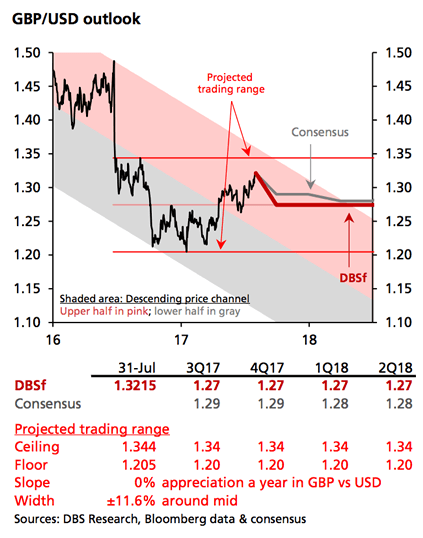Pound Sterling up 8% vs US Dollar in Past 100 days: Is there More Strength to Come?

The Pound to Dollar exchange rate has risen by over 8% in the past 100 days; something that won’t be welcomed by the UK’s exporters but it will certainly be welcomed by the nation’s importers who easily outweigh their exporting counterparts.
And of course the news will be welcomed by tourists looking to visit the United States and countries that peg their currency to the USD as we move through the Northern Hemisphere’s holiday season.
Perhaps more importantly, the appreciation in the Pound’s value against the US Dollar will go a long way in stabilising UK inflation which has soared in the wake of the large devaluation in Sterling following the UK’s decision to leave the EU in the June 2016 referendum.
Questions are however being asked as to whether or not this is a trend that can be sustained - just how high can Sterling appreciate against the US Dollar?
“Whereas EUR gains are confirmed as impulsive or trend-like equivalent GBP strength thus far in 2017 at least still looks potentially corrective,” says Lucy Lillicrap, a technical analyst at foreign currency brokers AFEX.
GBP/USD has yet to hurdle important-looking resistance at 1.3500 and even if seen multi-year resistance awaits toward 1.4000 (bottom end of the previous range).
Technical analysts such as Lillicrap look to make projections on a currency based on previous price action using charts. Charts are more than just a picture - they offer compelling insights into how a market is structured and where traders are likely to buy and sell a particular financial product.
“On this basis technical studies argue upside potential more limited relative to other similarly quoted pairings and while dips are evidently proving untenable as well for the moment effective support here is also somewhat thin below 1.2925/35 until 1.2775/1.2625 again,” says Lillicrap.
So a move below 1.30 is likely in Lillicrap’s view, but importantly it is not likely to be as deep as corrections seen in the past.
But it’s not just the technical strategists that are eyeing 1.35 as a key level that Sterling might not break above.
As we can see in the below set of projections from analysts at DBS Bank, the Pound to Dollar exchange rate is unlikely to break above 1.25:

“We remain cautious over the latest bout of GBP strength,” says a research note from DBS Bank in Singapore.
Analysts at the global financial services giant believe the Bank of England’s meeting on August 3 could see fewer (if any) member calling for a hike.
Such a scenario would certainly weigh on Sterling and potentially bring about a decline as expectations for an interest rate at some point in the near-future have actually risen over recent months.
Get up to 5% more foreign exchange by using a specialist provider. Get closer to the real market rate and avoid the gaping spreads charged by your bank for international payments. Learn more here.
US Dollar Weakness
The Dollar is however arguably the more important party in the GBP/USD equation.
The Dollar has been steadily falling through the course of 2017 as markets come alive to the fact US President Donald Trump will struggle to deliver on his agenda of slashing US taxes and boosting spending on infrastructure.
When Trump won the vote in November the Dollar surged in anticipation of such policies being introduced.
2017 has been a story of these gains being slowly given back by the Dollar as markets realised Trump couldn’t deliver.
The Dollar index - a measure of overall Dollar value based on a basket of key USD pairs - is near the floor of its two-year range seen before the US presidential election.
By end-July, the DXY (USD) Index had depreciated 9.1% YTD to 92.863. This was in spite of three Fed hikes in December, March and June.
But when it comes to Dollar weakness it is more than just Trump.
“The USD’s depreciation this year was blamed on US growth falling below trend in 1Q17, and inflation easing below the Fed’s 2-2.5% target,” say DBS Markets.
The question that is important now is how much further can the USD be reasonably expected to fall? Is it not looking oversold?
"The broader USD bear trend is well-entrenched across a range of time frames, suggesting that scope for significant GBP weakness is limited at that minor dips are a buy," says Shaun Osborne, a strategist with Scotiabank in Toronto.
“Once again we have a situation where the weakness in the Dollar is making an otherwise flaccid Sterling look robust. Last week’s 1.06% advance lifted the UK currency to its highest reading since last September and, given that the greenback is still losing ground, it’s possible that Sterling might have further to go in the near term,” says Bill McNamara at Charles Stanley.
That said, McNamara does see limits to the upside and notes it would still be surprising if this move extended much beyond the high from ten months ago, at 1.345 or so.
So there are certainly limits, even when viewing GBP/USD from the USD angle.
In a monthly foreign exchange briefing to clients DBS reckon the big theme in global FX at present is the likelihood of the Dollar stabilising.
“Looking ahead, the DXY (Dollar index) may find support as it nears the floor of its two-year trading range seen before the US presidential elections. US growth has returned above-trend in 2Q17. Republicans are also working behind the scenes on a tax reform plan,” say DBS.
Note too that the EUR/USD is looking oversold relative to fundamentals; any giveback in EUR/USD will likely fire up the broader Dollar complex and put GBP/USD at risk.
So in summary - more gains are possible but the scope of the advance is diminishing and either a protracted period of consolidation awaits or a pullback to below 1.30.
But we don’t see a rout taking place.
UK Economics: UK Manufacturing Data Signals Strong Pick-up in Activity but Construction Sector Lags
Latest data out of the UK economy confirms the manufacturing sector continues to see expansion as demand for UK exports expands.
IHS Markit and the CIPS reported at the start of the new month that their Manufacturing PMI survey reveals an acceleration in activity in the sector with a reading of 55.1 being reported for July, up on the previous month’s 54.2 and ahead of economist forecasts for 54.4.
The headline PMI was boosted by stronger inflows of new work, higher levels of production, improved job creation, longer supplier delivery times and a slight increase in inventory holdings.
However, the same optimism is not being reflected in the construction sector as the July construction PMI confirmed a slowdown with a reading of 51.9 suggesting the sector is just about growing.
Markets had forecast a reading of 54.5.
This represents the weakest construction performance since August 2016 as commercial work fell the fastest in 12 months. New orders were seen declining with job creating also falling.
"Commercial building activity slowed for the first time in five months and was the main drag on the Index. Housing, the shining light of the sector eased marginally, but produced the slowest growth since April, as parallels with the darker days of Brexit, worries about the UK economy and post-election uncertainty can be seen across the construction sector," says Duncan Brock, Director of Customer Relations at the Chartered Institute of Procurement and Supply.
But the construction data was swept aside by foreign currency traders who are looking at the wide picture - construction accounts for a small portion of UK economic activity.
Rather, it was news that the NIESR is forecasting a strong recovery in overall economic growth over the next two years that got markets ticking. More details on why this is good news for the Pound can be found here.




